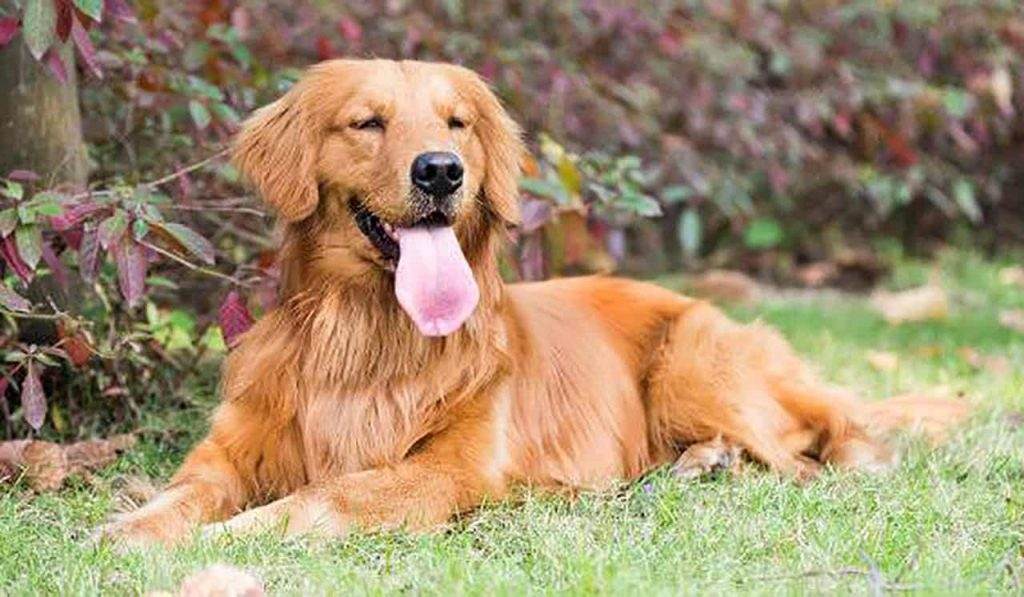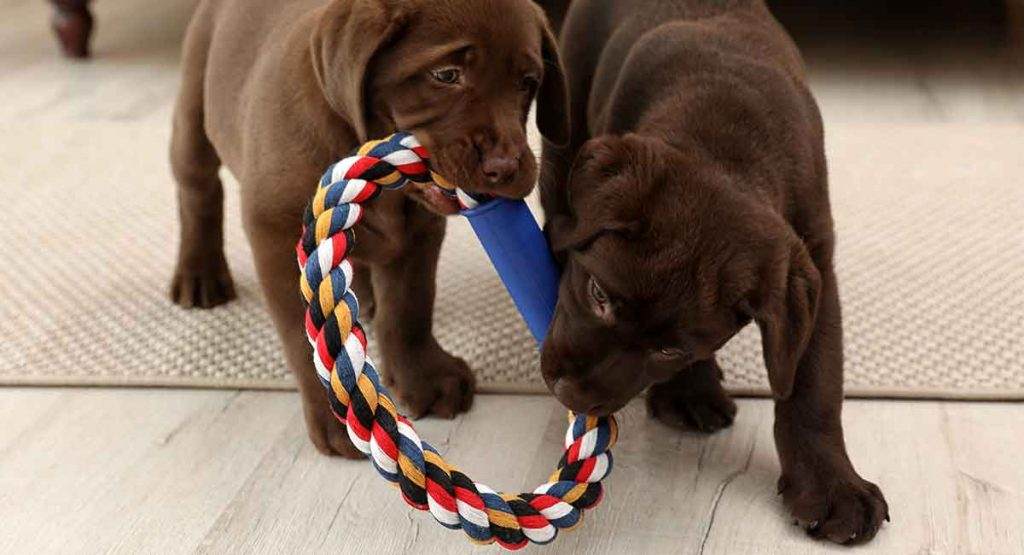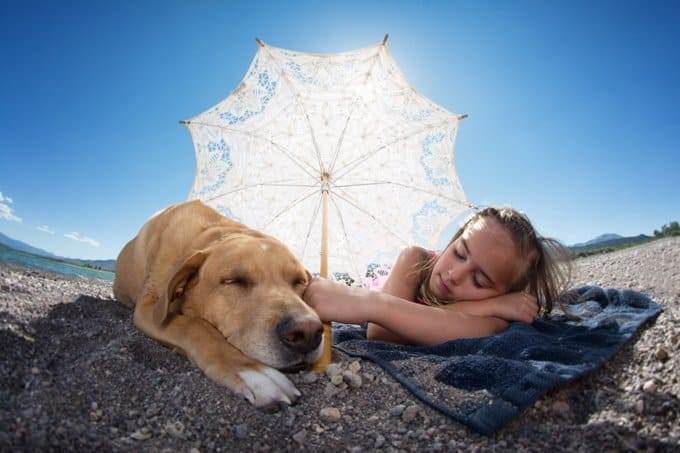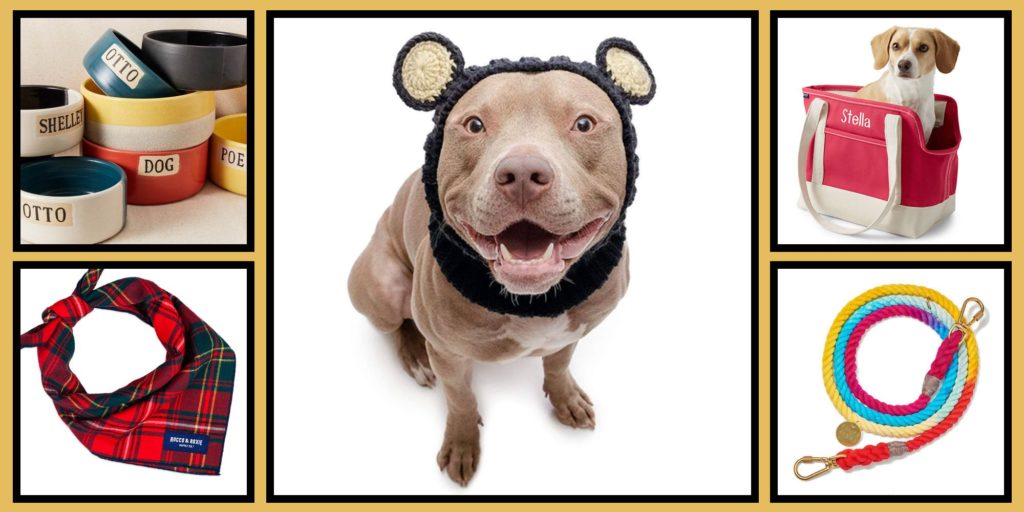It has been seen in several surveys carried out across the world that white dog breeds are the most popular among pet parents. Chalk it up to their small sizes or incomparable cuteness, whatever the reason may be – it is clear that one is likelier to buy or adopt a white breed dog than any other. In the USA alone, up to 60% dog owners have been found to have white breed dogs in their homes.
The tricky part is that caring for these dogs becomes more difficult because of their milky coat. There are many challenges that one faces while taking care of such dogs. They do require baths more frequently and certain insects and bacteria are more likely to harm them as well. If you are looking to adopt a white breed dog, check out the exhaustive list below for a complete guide for the same (including ways to care for them).
1. Bichon Frise
Bichon Frises are like little balls of cottony cloud. They are gentle, happy-go-lucky dogs that make for excellent house pets. They are best distinguished from other white dog breeds through their appearance, which gives them their name, as Bichon Frise in French translates as “a fluffy white dog”.

These dogs generally weigh less than 12 pounds, mostly between 7 to 10 pounds. Their signature white fluffy fur may contain curls and specks of cream and apricot colours. Their pure white fur colour and roundish shape makes them resemble little cotton balls.
Origin of the breed: This breed’s origin can be most certainly traced back to France. The breed considered as Bichon Frise in today’s age is a descendent of the water spaniel and the poodle. Since these are both breeds commonly used in sport, the Bichon Frise is also usually energetic, adventurous, and active. This is why they make for great companion dogs.
How to care for them
The upkeep and maintenance of a Bichon Frise is rather expensive. They are quite high maintenance in nature because of their delicate nature and appearance. Bear in mind the following points if you are a pet parent to a Bichon Frise:
- These dogs are generally hypoallergenic but you must leave nothing to chance and consult your vet before taking the Bichon Frise home.
- These delightful creatures require daily brushing because of their puffy curls. This should be done to avoid tangling and matting of fur. You can choose to do this yourself or take your dog to a groomer for regular appointments. Either way, unless this is done regularly they will look disheveled and lose their rounded and well groomed look.
2. West Highland White Terrier
Often fondly referred to as the Westie, the West Highland White Terrier is a small yet robust dog breed from the Scottish highlands. Because of the cold Scotland weather and the purposes this breed originally served, over time these furry creatures have developed two coats of white fur. These pups are active, smart, and are bundles of joy that make for excellent companions.

Origin of the breed: These dogs were mainly bred and trained to hunt for vermin. These dogs were particularly suited for the purpose because of their distinctive appearance and a sharp white coat of fur, which makes them stand out in a crowd.
Since they were primarily used for hunting these dogs tend to be enthusiastic, playful, and require regular exercise. Despite their compact size, they weigh about 15 to 20 pounds.
How to care for them
- The white coat of fur is always a cause of concern with active dogs like this that are constantly on the move. They require regular brushing and regular grooming sessions (at least once a month) in order to retain their flawless coat.
3. The Samoyed
The Samoyed comes in both medium and large breeds, but they weigh just about 5 to 8 pounds. They are majestic and dignified creatures, and are covered entirely by a really fluffy and thick coat of white fur. This makes them sturdy and resistant to very cold weather conditions.

They have a slight built but their fur is long and gorgeous, with a thick layer near the neck region, punctuated by a small black nose and dark eyes. The Samoyed breed has a very distinguishable tail that curls over the back. Some dogs of this breed may be found with creamy or biscuit coloured fur.
Origin of the breed: This breed of dog has such a thick coat of fur owing to the fact that they originate from the plains and mountains of Siberia. This breed got its name from the Samoyed people who used these dogs to manage reindeer, haul wood, shift sledges, and hunt for sport.
How to care for them
- The thing to keep in mind is that you must not acquire these dogs unless you live in a place where temperatures go really low. The Samoyed is built to thrive in cold weather and they find it difficult to survive in areas where the mercury does not dip sufficiently low.
- Another important point to remember is that these dogs shed their undercoat annually or seasonally. It may get difficult to keep your house clean during this time and they require proper grooming while shedding and re-growing the fur.
4. The American Eskimo
The American Snowman resembles a tiny ball of snow. In fact these dogs are bred in small and standard sizes and the really small ones actually look like the white soft toys available in toy stores. Immeasurably adorable, these dogs come in a fluffy double coat. They are essentially a spitz breed and thus they have a petite build.
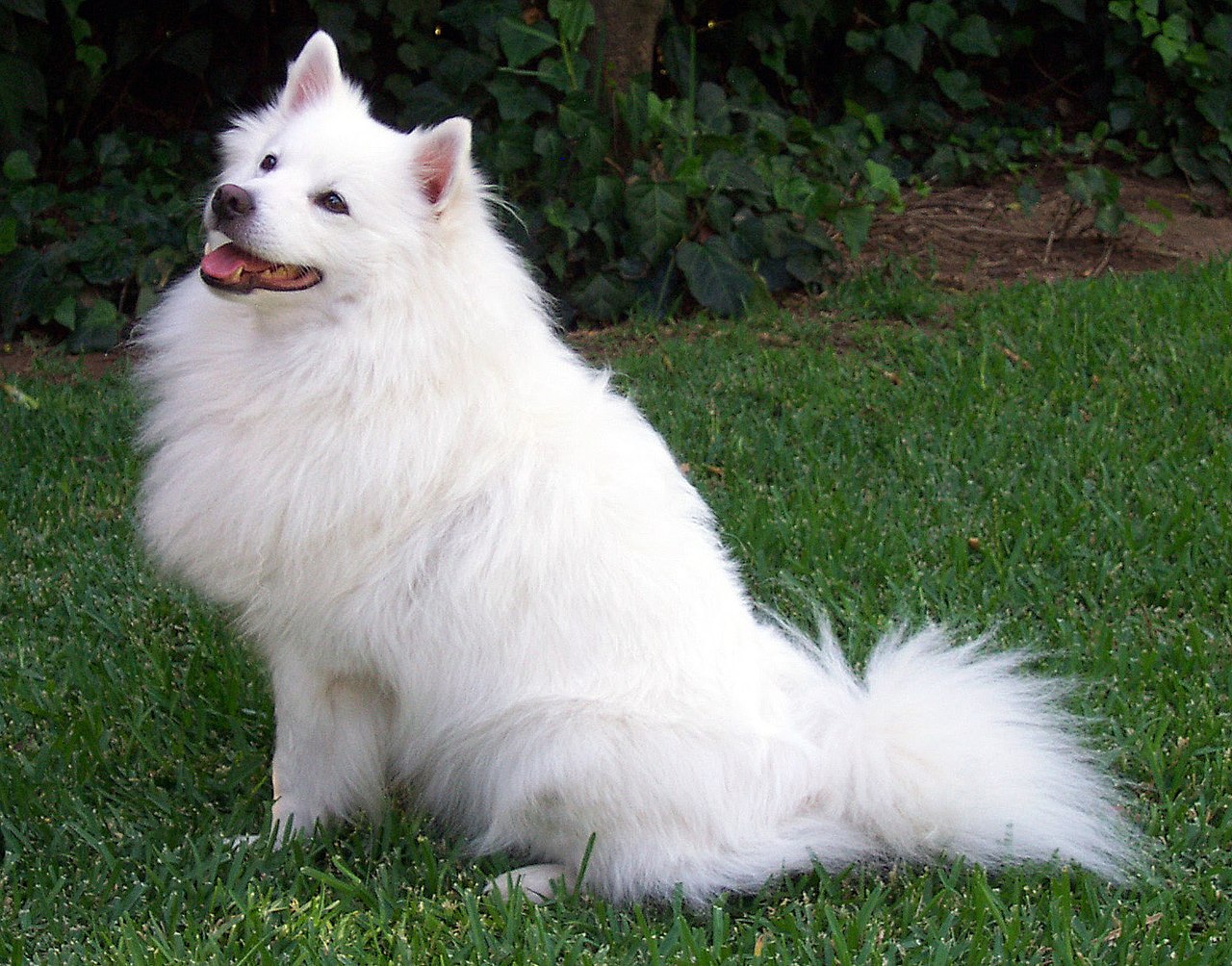
The standard size of this breed is 15 to 20 inches, whereas the toy sizes may be as less as 10 to 12 inches tall. Correspondingly the standard build pups can weigh as much as 35 pounds but the miniature ones weigh only about 7 to 12 pounds.
Irrespective of their size, dogs of this breed are unfailingly intelligent and observant by nature. They are curious about things around them and because of their smart nature they are very well suited for training.
Origin of the breed: These dogs were bred in the Midwestern United States towards the end of the 19th century. Earlier they were known as the German spitz because they were used as farm animals by German settlers. These dogs have been known to be used in a variety of capacities, including a brief stint in circus acts. The breed derived its current name after they were used extensively during World War I.
How to care for them
- Eskies are very friendly and social dogs and should be allowed to spend a large portion of their time indoors. However they require a scheduled structure of life to thrive in and you must set proper timings for feeding, exercise, bathing, and other things.
- You must brush the Eskie properly before giving them their bath in order to avoid matting of fur. Take care to shave the fur near the feet regularly as it tends to grow thick near that region, causing difficulties in movement.
- They are easy to maintain but may require frequent grooming because they tend to shed their fur constantly.
5. The Bolognese
The Bolognese is a breed very similar to the Bichon Frise not just in their physical appearance but in their personalities as well. There are some very subtle but noticeable differences, however. For instance, the Bolognese appears less groomed and compact because of their wavy hair and rather longish fur. They are also known to be less excitable than the Bichon and are generally more composed.
They do have very friendly natures and may seem cuter than the Bichon even because of the small black nose that peeks out from the wavy white fur. They are small in size, only about 10 to 12 inches tall, and weigh even less – just about 7 to 10 pounds.
Origin of the breed: This breed originates from the northern Italian city of Bologna. They are in essence a different line of the same breed as the Bichon Frise and thus may be difficult to distinguish from the parent breed.
How to care for them
- The Bolognese breed has a stout coat of long, wavy white fur. Because of the length of the fur it becomes difficult to maintain their appearance and groom them regularly.
- The good news is that they do not have to be groomed in such detail as the Bichon Frise, but they do require extensive brushing of the coat in order to keep it from tangling and matting. Regular haircuts may also be necessary.
6. Coton de Tulear
The Coton de Tulear is one of the most exquisite white breed dogs. They have soft and voluminous fur that makes them appear like a cloud as they bounce along, and their small beady black eyes too are covered by locks of fur. They are mostly white dogs but can sometimes be found with tan and yellowish wisps of hair in their white coat.

The Coton de Tulear is a lively, energetic, and very affectionate dog that makes for a wonderful companion. They adapt very easily to the families that adopt them and bond especially well with children in the family. They have been known to be more active after sundown and they enjoy a host of different activities.
These dogs are of small to medium size and can weigh up to 15 pounds. They generally have a sturdy built despite their flowy cottony appearance.
Origin of the breed: This breed was the chosen pet for the elite upper class of Madagascar. If records are to be believed then in the earliest days these pups were frequently found aboard ships as companion to sailors when the voyages were long and tiring.
How to care for them
- Because of their generally carefree yet not unkempt appearance, these dogs seem to be easy to groom and handle. That may not be the case, because to maintain this delicate balance they require a wash twice a week and a thorough combing every day.
- The texture of their coat is such that when they shed the hair tends to get trapped in the coat of the folds. To allow the hair to grow normally without getting matted, it is necessary to brush properly.
- Please bear in mind that if these dogs are not groomed regularly, owing to the quality of their furry coat they may need to be shaved to allow the fur to grow back thick.
7. The Great Pyrenees
The Great Pyrenees breed is generally considered as the largest among the white dog breeds. They can be up to 35 inches tall and weigh nearly 100 pounds or more. They have two thick coats which are not entirely white – there may be a tinge of ash or brown in the fur.

Do not let their size fool you, for these are extremely gentle and patient dogs, and are known to be fiercely loyal. These dogs are known to be nocturnal and as such can be used as guard dogs. Although generally calm, they can become ferocious and defensive if faced with predators or in extenuating circumstances.
Origin of the breed: This breed has been traced back to several centuries to the Central Asia area. The current breed of the Great Pyrenees had been later brought to the Pyrenees mountain ranges and gets its name from the region.
How to care for them
- These dogs shed all through the year and require thorough brushing several times a week. Otherwise the shed fur will be all around your house and floors.
- The double coat is weather resistant and acts as a natural cover against dust and dirt. Hence they do not require to be bathed too frequently.
- This breed has often been known to have gastric issues, which may be prevented by consulting your vet regarding the kind of food they can consume. A general rule with the Great Pyrenees dog is to give them small meals through the day and allow light exercise.
8. Dogo Argentino
This dog is easily one of the most forceful ones among white dog breeds. They are rather large in stature with a short and silky coat, found occasionally with black spots on the skin. They can grow to 27 inches in height and weigh 100 pounds.

They may be confused with the American Pit Bull Terrier because of their appearance, but the Dogo Argentino is much taller. They are usually trained for other purposes but they may also be domesticated. To that end they are incredibly warm and loving, and their natural protective instincts make them affectionate of children.
Origin of the breed: This breed came into being in the 1920’s for big game hunting in Argentina. Because of their brute strength, loyalty, and single minded ability to concentrate they were later used as Search and Rescue dogs. They are also largely employed by military forces in the USA.
How to care for them
- Owing to the nature of their coat these dogs do not shed fur and are very easy to groom and take care of. One only has to take care they do not get exposed to sunlight for too long because their short coat is not protective enough to prevent sunburn.
- Pigment related deafness has been known to afflict dogs of this breed and only regular checkups by the vet can prevent or resolve this problem.
9. Japanese Spitz
The Japanese spitz is a small, stout snowy dog that is sometimes mistaken for a Pomerian. They come in various sizes but are most commonly found to be 15 inches tall, weighing about 10 to 25 pounds (depending on size). They share with other spitz breeds a thick coat, lively eyes, and a curled up bushy tail.
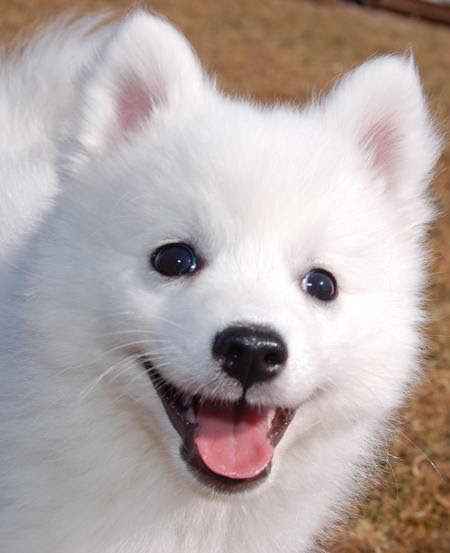
They have a straight outer coat and a softer and thicker coat below. A thick ruff of fur is visible around their neck. Their dark eyes, nose, and padded feet are in sharp contrast to the silky white fur. Active, loyal, and dependable, these dogs make for excellent companions as they are one of the friendliest among the white breeds.
Origin of the breed: In the 1920s a number of Spitz breeds were crossbred in Japan, resulting in the creation of the Japanese spitz as we know today.
How to care for them
- It is remarkable that despite their thick coat they do not shed that much.
- Due to the nature of their coat, dirt tends to fall off easily. They can be cared for by a simple brushing of their fur occasionally.
- Their coat is also easily dried and you do not have to worry about tangling of fur after giving your dog a bath.
Whichever white dog breed you choose to go for, it is important to understand that they will perhaps require more care and attention that other breeds because of their grooming needs.
Table of Contents

